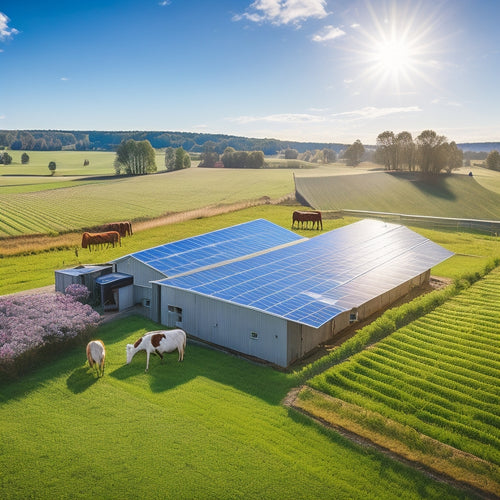
5 Best Home Efficiency Tips for Homeowners
Share
You can considerably reduce your energy bills and enhance your home's overall efficiency by implementing a few simple, yet impactful, changes to your daily habits and household systems. Start by replacing incandescent bulbs with LED or CFL alternatives and investing in solar power systems to promote energy independence. Seal air leaks around windows, doors, and vents to improve insulation, and upgrade to ENERGY STAR labeled appliances to reduce energy consumption. Additionally, create a thermostat scheduling routine, use LED alternatives for lighting, and unplug idle devices to save energy. By following these tips, you'll be well on your way to a more efficient home, and there's more to investigate to maximize your savings.
Key Takeaways
- Replace incandescent bulbs with LED or CFL alternatives to reduce energy consumption and extend lifespan.
- Seal air leaks around windows, doors, and vents to improve insulation and enhance energy savings.
- Install smart thermostats that learn user schedules and optimize energy use for increased efficiency.
- Unplug idle devices and replace traditional power strips with smart strips to eliminate standby power consumption.
- Conduct energy audits to identify inefficiencies and implement changes for significant energy savings over time.
Simple Swaps for Big Savings
You can make a notable impact on your energy consumption and costs by implementing simple changes in your daily habits and home setup.
Start by swapping out traditional incandescent light bulbs with LED or CFL alternatives, which use considerably less energy and last longer.
Additionally, consider investing in solar power systems, which can enhance property worth over time, and promote energy independence and reduce grid reliance.
Upgrade to energy efficient appliances, such as those with the ENERGY STAR label, to reduce your energy consumption.
In the bathroom, install water saving fixtures like low-flow showerheads and toilets to conserve this precious resource.
These small changes can add up to big savings on your utility bills over time.
Seal Air Leaks and Save
Many air leaks in your home are hidden from view, but their impact on your energy bills and comfort is undeniable. You may not see them, but you can feel them in the form of drafty windows and cold floors.
In fact, biogas energy solutions can be an effective way to reduce waste disposal costs and generate clean-burning fuel.
To seal these air leaks, start by inspecting your home's exterior, paying attention to gaps around windows, doors, and vents. Use caulk or weatherstripping to seal these gaps, and consider insulation upgrades to reduce heat loss.
Don't forget to check your attic, basement, and crawl spaces for hidden air leaks. By sealing these leaks, you'll not only save energy but also reduce your energy bills and create a more comfortable living space.
Smart Thermostat Strategies
Sealing air leaks is just the beginning of creating a more energy-efficient home.
Now, it's time to optimize your thermostat's performance. You can do this by implementing smart thermostat strategies. Start by creating a thermostat scheduling routine that aligns with your daily habits.
For instance, you can program your thermostat to lower the temperature by 5-10°F when you're away from home or sleeping. This simple adjustment can greatly reduce energy usage.
By reducing your dependence on grid electricity, you can increase energy independence and minimize the impact of grid outages.
Additionally, consider installing a smart thermostat that can learn your schedule and preferences to optimize energy consumption.
Bright Ideas for Lighting
Efficiency shines brightest when it illuminates the path to savings. You can brighten up your energy-saving efforts by incorporating LED alternatives into your lighting scheme. These eco-friendly options use considerably less energy than traditional bulbs and last longer, making them a smart investment.
Consider maximizing natural illumination by placing mirrors opposite windows to reflect sunlight and reduce the need for artificial lighting. For ambiance, use mood lighting to create a warm atmosphere without wasting energy. Task lighting, focused on specific areas like reading or cooking, can also help reduce overall energy consumption.
Don't forget to update outdoor fixtures and install dimmer switches to fine-tune your lighting levels and reap the energy-saving benefits.
Power Down With Efficiency
As you've optimized your lighting scheme, it's time to tackle another notable contributor to energy waste: idle appliances and devices.
These energy vampires secretly drain power even when turned off but still plugged in. Performing energy audits can help identify areas of inefficiency, and appliance upgrades can noticeably reduce energy consumption.
Some simple changes you can make include:
- Unplugging chargers, TVs, and computers when not in use
- Replacing traditional power strips with smart strips that automatically cut power to idle devices
- Upgrading to energy-efficient appliances with the ENERGY STAR label
- Using a whole-house plug load controller to eliminate standby power consumption
Frequently Asked Questions
What Is the Ideal Temperature for My Refrigerator and Freezer?
You set your refrigerator settings between 37°F and 40°F, while maintaining a freezer temperature around -18°C (0°F) to guarantee peak performance, food safety, and energy efficiency.
How Often Should I Replace My Home's Air Filters?
You'll want to replace your home's air filters every 1-3 months, depending on the type: fiberglass filters need monthly swaps, while pleated or HEPA filters can last up to 3 months, ensuring ideal air quality and system efficiency.
Can I Use Power Strips With Extension Cords Safely?
You can use power strips with extension cords safely if you follow power strip safety guidelines, such as choosing strips with built-in surge protectors and adhering to extension cord guidelines like not exceeding maximum load capacities.
Are Solar Panels Worth the Investment for My Home?
You're considering solar panels, evaluating cost savings against the upfront investment; while they'll reduce your carbon footprint, you'll need to assess your energy consumption and local incentives to determine if they're worth it for your home's environmental impact.
How Do I Know if My Home Has Adequate Insulation?
You determine if your home has adequate insulation by checking for energy loss through walls, floors, and ceilings, then selecting the right insulation types, such as fiberglass, cellulose, or spray foam, to minimize heat transfer and optimize energy efficiency.
Related Posts
-

What Do I Need to Know About Farm Solar Panels
When considering farm solar panels, you need to assess costs, benefits, and technical specifics. Initial investment c...
-

Advantages of Solar Generating Systems Over Traditional Energy
Solar generating systems provide several key advantages over traditional energy sources. You'll experience lower long...
-

Top Camping Water Bottles for Adventure
When you're out adventuring, picking the right camping water bottle is essential for staying hydrated. Look for durab...


